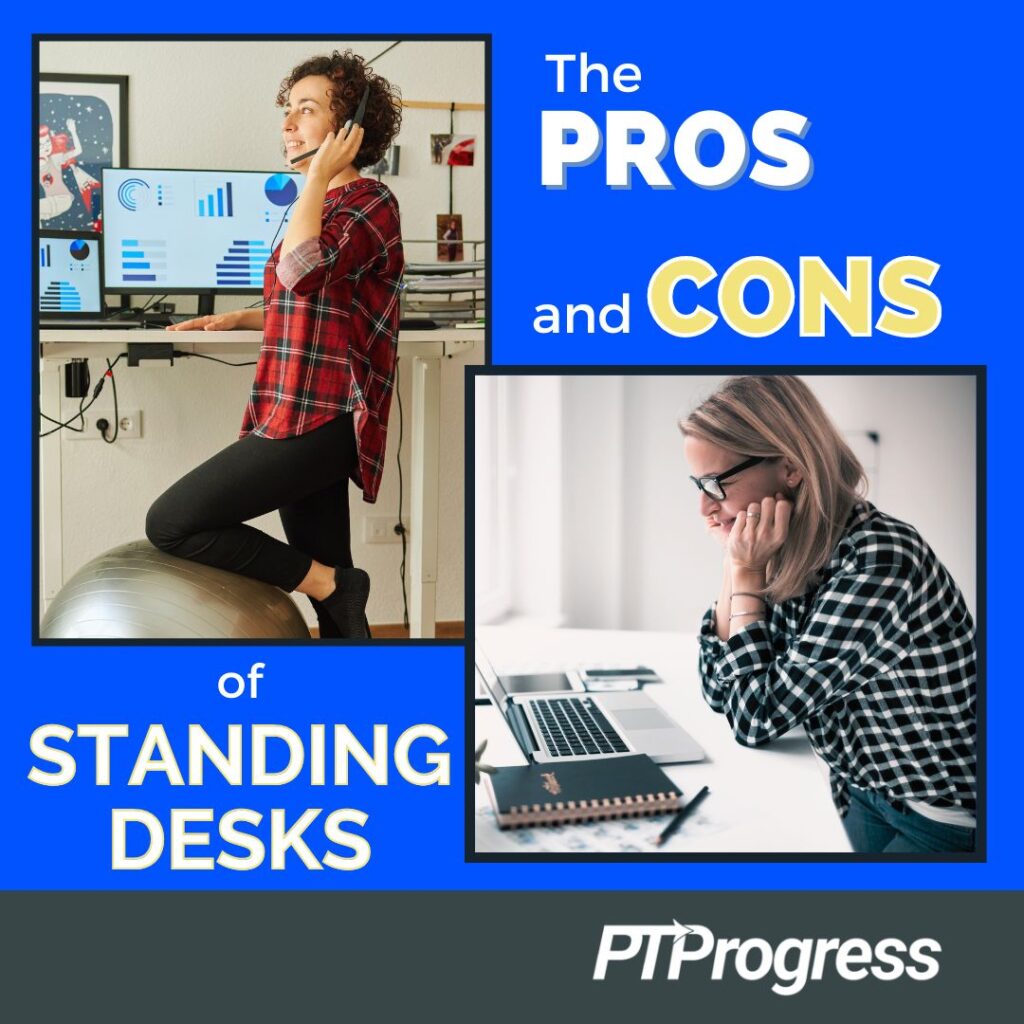
Standing desks have become the earmark of an ergonomic office. Their enthusiasts are quick to defend a long list of purported health benefits, including better posture and productivity. But what is it really like to stand up to work? Are standing desks overrated?
As a physical therapist and longtime standing-desk-worker, I have some perspective to offer on the pros and cons of standing desks. The desks I use are from FlexiSpot, so I’ll refer to their products throughout the post.
10 Pros and Cons of Standing Desks
Standing desks come with a host of benefits as well as a few liabilities. Let’s start with the good stuff—the pros to using a standing desk.
The Pros:
1. It keeps you out of your chair
If you sit chained to a desk all day, your body may be aching for a change. Prolonged sitting has been linked to premature mortality, metabolic illness, and cardiovascular disease. Although there’s no true substitute for light exercise, standing allows you to stretch your muscles and can reduce lower back discomfort. Throughout the day, a well-fitting standing desk can help you maintain better posture and avoid becoming a hunchback.
2. It allows for a variety of postures
It’s not sitting per se that’s so bad for you. Rather, it’s prolonged sitting, or a sedentary lifestyle, that is so often equated to smoking in terms of detrimental effects. For many people, sitting can feel like a dead end, whereas standing is a gateway to posture variability. A height-adjustable standing desk allows you to vary your posture from sitting to perching to standing, with stretching in between.
3. Standing burns more calories than sitting
Standing is a more active position than sitting because your body has to engage your back and core muscles to keep you upright, burning more calories. It’s only an extra 50 calories or so each day, but that can add up over the workweek and help curb weight gain.
4. Many standing desks can customize and even program different heights
To get the most out of your standing desk, you’ll want one that allows for at least two height settings, for sitting and standing. Pick a desk with a memory and you won’t have to play Goldilocks each time to get it “just right.” The desk will remember the setting and adjust to it in seconds!
These height-programmable desks not only make your life more convenient, they also allow for better workspace sharing, whether it’s with your partner at home or your coworker in the office.

5. Standing desks come in a range of styles and formats
When it comes to standing desks, one size won’t fit all. But the good news is that there are nearly as many types of standing desks as there are sedentary activities. The standing desk market includes gaming desks, drafting tables, sewing tables, L-shaped desks, multi-level workstations, and even school desks for children. Nowadays you can easily find a desk to fit almost any task in any corner of the room.
6. A standing desk can be easy to assemble
You’d think a desk that can float up and down while supporting hundreds of pounds would require a lot of machinery. However, the desks from FlexiSpot and their competitors are compact, relatively lightweight, and easy to assemble. For example, the FlexiSpot Comhar desk arrives in 4 parts with 16 screws, which is remarkably minimal for such a large piece of furniture.
You don’t always hear the dark side of the standing desk life, especially from an online blog post. So here are a few ugly truths behind standing desks.
The Cons:
1. It’s pricier than a regular desk
It’s somewhat of an apples-to-oranges comparison, but a standing desk is often pricier than its sitting equivalent. Office furniture is generally considered a worthy investment, however, especially if it leads to better productivity or ergonomics. And your standing desk doesn’t have to be prohibitively expensive. Start with a low-cost, reputable company like Flexispot and you can enjoy a high-quality product without the sticker shock.

2. Standing desks have limited storage options
A big, cavernous desk isn’t conducive to the standing desk lifestyle, and most height-adjustable desks prioritize versatility over storage space. Your standing desk could include a mini drawer, and you may even find one with two full-size drawers, but otherwise don’t expect a standing roll-top.
3. You’ll lose your lap
Eating lunch or juggling items is easier when sitting down, mostly because your lap is there to catch things. Keep your standing desk clutter-free and you might not be as inconvenienced when you need to multitask.
4. Standing comes with its own health risks
Again, the body needs posture variability. If you get a standing desk and then only stand for the rest of your working life, you’ll still end up with some occupational hazards, just different ones, such as varicose veins and sore feet. Set a timer to rotate your sitting and standing postures, fit in regular walking breaks, and make sure you have supportive footwear for when you stand at work.
Remember that, like everything in life, balance is best, and a variability of postures and movements is the key to long-term health.
Weighing the Pros and Cons of Standing Desks
Ultimately, as the consumer you must weigh the pros and cons to determine if a standing desk is right for you. With so many types of desk configurations and accessories available, there’s a good chance you’ll find a workstation that can improve your productivity while minimizing the physical strain of a full day at work.
If you’re ready to add a height-adjustable standing desk to your workstation, check out my review of the FlexiSpot Comhar standing desk. And if you’re not interested in standing up just yet, consider upgrading your chair to one of these ergonomic office chairs.

